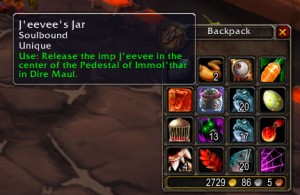
Congratulations, New GM! You have your Guild Charter and Rules ready, and that website is up and running. Even though you’re not raiding yet, your next step is to decide what to do with the funny purple stuff that drops when you kill things. And yes, you must make this call even before you have enough members to stare down High King Maulgar. When I interview new recruits, they almost all ask me how my guild handles loot. If you create a fair means of distributing shiny epix, and you’re well on your way to having a healthy, happy, boss-destroying raiding guild. You must pick a loot system from the beginning and stick with itâ€â€the worst thing you can do is vacillate between systems and potentially cheat your members out of their just deserts.
Loot system basics:
Almost all raiding guilds use some variation of one of two types of gear distribution systems. The first is Loot Council, in which the officers or other elected body decide who gets each piece of gear that drops based on a complex ratio of need and merit. The other system is DKP, an archaic gaming term that stands for Dragon Kill Points. DKP systems allow raiders to earn points for killing bosses (or anything else the guild leadership decides is fair) and spend them for gear. There are benefits and drawbacks to both types of systems. Not everyone agrees with me either–based on her own personal experiences, Wyn gives you almost the opposite advice that I will. Listen to both of us and draw your own conclusions.
How do I choose?
Before you pick either DKP or Loot Council, you must decide what you want your loot system to accomplish. The following is a basic guide to the implicit goals of both system types.
1. Loot Council
This type of system is designed to optimize gear drops by placing them in the hands of those who will have most use for them. This may sound like the best players receive every item, but in practice, this is not true. A well-functioning Loot Council uses gear drops both to reward players for excellent performance and to help raise players to the group standard. Sometimes–perhaps often–the Council will reward the weakest player in a class and spec. All decisions are made for the good of the group, and no good items are sharded. Each member of the Loot Council must be extremely well-informed about the loot tables themselves and about the needs, wants, and skills of the player base. If a player on the Loot Council is interested in a gear drop, he or she generally bows out of the discussion on the item in question.
2. DKP
All DKP systems invest their players with “buying power,” and players get to decide what is most important to them. In all such systems, players tend to save for the best drops for themselves, assuming that they can identify them. DKP systems award gear based on attendance–more boss kills means a larger share of the loot. In this way, they can help a guild retain players over the long haul, because they can objectively track the benefits of consistent raiding. These systems are democratic in that they do not distinguish among players based on skill. As such, however, they do not always place items with the player who will get most use out of them. In addition, middling quality items will often be sharded as players learn to prioritize.
Drawbacks: Nutshell Version
Neither of these systems is perfect. Assuming real-life implementation, with no extreme chicanery, shenanigans, or other forms of bad behavior on the part of officers or raiders, here are the typical problems each system type experiences.
Loot Council:
1. The drama llama rears its ugly head
Human nature dictates that each player will be more aware of her own skills and contributions than those of others. This kind of blindness virtually guarantees that some people will not be happy with any given loot decision.
2. Inefficient use of raid time
The Loot Council will probably discuss most items as they drop. This could cost the raid upwards of 5 minutes at the end of every boss kill, which may put the guild in a crunch for longer instances with large numbers of bosses.
3. Inaccurate tracking
Unless the guild uses a mod to track drops awarded, loot may be distributed unevenly. The memory is a notoriously inaccurate instrument. Without hard numbers for attendance or drops rewarded, the Loot Council may unintentionally give more to some and less to others.
4. Bias
Human error plays a large part in the Loot Council system. We are all biased–our thoughts and feelings affect us at every moment, even though we don’t realize it. I’m not talking about malicious prejudice–I’m talking about the little unconscious leanings that occur even when we mean no harm. It would be nigh-impossible for a Loot Council to be entirely neutral toward every raider in the guild.
5. Lack of inherent structure
If you choose Loot Council, you will have to come up with the operating rules yourself. Guilds accomplish this in highly unique ways–poke around some websites and copy good ideas. You will have to determine on what basis loot is awarded, who gets to participate in the decision, and how much time will be allowed for debate.
DKP:
1. Sometimes people don’t know what is best for them
Your players will spend dkp as they like, and some of them will use their points unwisely. You cannot force people to research your loot system and their class drops and come up with the absolute best strategy. People may hoard points, or they may spend them on the “wrong” items. Many perfectly serviceable pieces might end up being disenchanted or given away for off-spec.
2. It won’t stop the QQ
I can almost guarantee that the drama will be less than with Loot Council, but people will still be upset when they don’t get what they want. The complaints will be more intense as the item value increases. Remember that random loot is random, even though your dkp system is not.
3. Inaccurate tracking
If you’re using a pencil-paper system, errors will happen, and they may render the system meaningless. I strongly advocate tracking DKP with a mod if you can. If that is impossible, make sure you deputize one officer to update it, and beat him with your Riding Crop if he misses a day.
4. Every system can be played
Any time you put power in the players’ hands, there will be ways for an individual to work the system to his advantage. Most players won’t try–they will play because they enjoy it, and they’ll put in the exact same amount of participation no matter what loot system the guild uses. Others will find the exact right equation of play time to maximize their drops. It doesn’t mean they are bad people or bad players–sometimes it just goes right along with other types of min-maxing behaviors, which most raiding guilds encourage. For a concrete example, if your guild uses zero-sum dkp, points are only awarded when players take loot. For a certain player, this practice de-incentivizes progression nights, because they may earn nothing at all for a night full of wipes. Alternately, if your guild uses a positive sum dkp system, you might weight progression raids very heavily and in turn de-incentivize farm content.
5. You will have to choose a system flavor carefully
People have been playing MMOs for several years now, and there are many types of systems. In order to choose a specific DKP system, you will have to do a level of research that the Loot Council folks won’t even dream of.
DKP system types
If you’ve thought through your decision, and you’ve decided to go with DKP, here is a basic guide to system types. They all have the same core principles–democratic distribution and rewards that increase with attendance–but they manifest those principles in radically different ways. Each of these systems assumes that the person with most DKP will be offered first choice on items.
Zero-sum DKP
This system is for math nerds only–the basis of the system is that the raid’s total DKP always sits at 0. Points are awarded when a piece of gear is taken. For example, if I take the Thunderheart Helmet from Archimonde, its value will be subtracted from my DKP. For the sake of argument, let’s just say I lost 240 points. The other 24 people in the raid will be awarded 1/24 of the points I just spent, or 10 points each. This is one of those systems that really, really requires a mod to track, because you will have to recalculate after each piece of loot is awarded. The guild will also have to decide how many points each item is worth, because after all, not all pieces are created equal.
Positive-sum DKP: Additive
This system is similar to zero-sum dkp, but it allows the guild to add points to the system for anything and everything, including attendance and progression. As with zero-sum, each item is worth a certain number of points, and when a player receives a drop, the item’s value is subtracted from her total. Players may go below zero. These systems tend to get very, very inflated, and the gap between the bottom of the top can be just crazy.
Positive-sum DKP: Relational
The basic system of this type is Ep/Gp, which I must say is my favorite of all possible systems and the one my guild uses. A person’s DKP is a ratio calculated from her Effort Points divided by her Gear Points. Effort points are typically awarded either for boss kills, with each boss assigned a specific value, or for minutes of participation. My guild awarded points for boss kills in TBC but we’re switching over to an easier, more automatic points per minute system for Wrath. Ratios always stay above zero, and if you implement the system as intended (which I STRONGLY suggest), decay controls inflation. To decay the system, you reduce everyone’s EP and GP by a certain percentage at determined moments. The system designers mention 10% per raid as a good figure, and I tend to agree. The purpose of decay is to shrink the gaps in the list–this practice lets new players move up faster despite lower total attendance. In addition, players who have a long dry spell with no loot will remain near the top of the list even after they take their first item, making things more fair over the long haul. This process, in combination with the decay, also tends to discourage hoarding. The cherry on top of the system is the excellent mod that comes with it. The item values are built-in, and anyone with the proper clearance can update the system during the raid. I’ve been master looting for my guild using this system since January, and it works like a charm. The only caveat is that you must back up the data every week–content patches almost always wipe the system.
Suicide Kings
What would happen if you had 100% decay on Ep/Gp? You’d have Suicide Kings. This sorta-system belongs in the DKP list, but just barely. To use Suicide Kings, random roll all of your members into positions and arrange them in a list with number 1 at the top. Person #1, regardless of attendance, skill, or whatever, will have first crack at anything that drops. When he takes something, he will move to the last position. Suicide Kings is extremely easy to track, even with a pencil-paper method, but you may see extreme problems with hoarding or with raider apathy. Expect some raiders only to show up if their names are near the top.
Other rules:
Any system works better if you have some courtesy rules or guidelines in place. Heck, I’ve even seen random roll work for the top alliance guild on our server, and it’s because their guild has a culture of sharing. All guilds should encourage players to be kind to their fellows and to pass things when they can afford to. In addition, no matter what system you choose, your officers or class officers should not hesitate to give advice on gear choice. If possible, persuade people out of bad decisions. Sometimes you will have to lay down the law. For example, if a paladin wants to spend her DKP on cloth healing gloves that are also a significant upgrade for your priest, don’t let her do it. In addition, some guilds make a special exception for their main tanks and gear them up first. We have never done that, and our tanks are well-geared just because their attendance is good. If you want to move very fast, though, you may need to get that gear on the tank regardless of his DKP. Likewise, if one of your players needs to perform a special role, make sure he or she has the gear to do it. For example, my guild awarded the first Void-Star Talisman to our warlock tank for Leotheras. Every member of the guild was happy about the decision, because we all wanted to get to Leo as fast as possible.
And lastly, good luck. You’ll need it to get through the loot system minefield without life-threatening injury or, at the least, major scarring.


